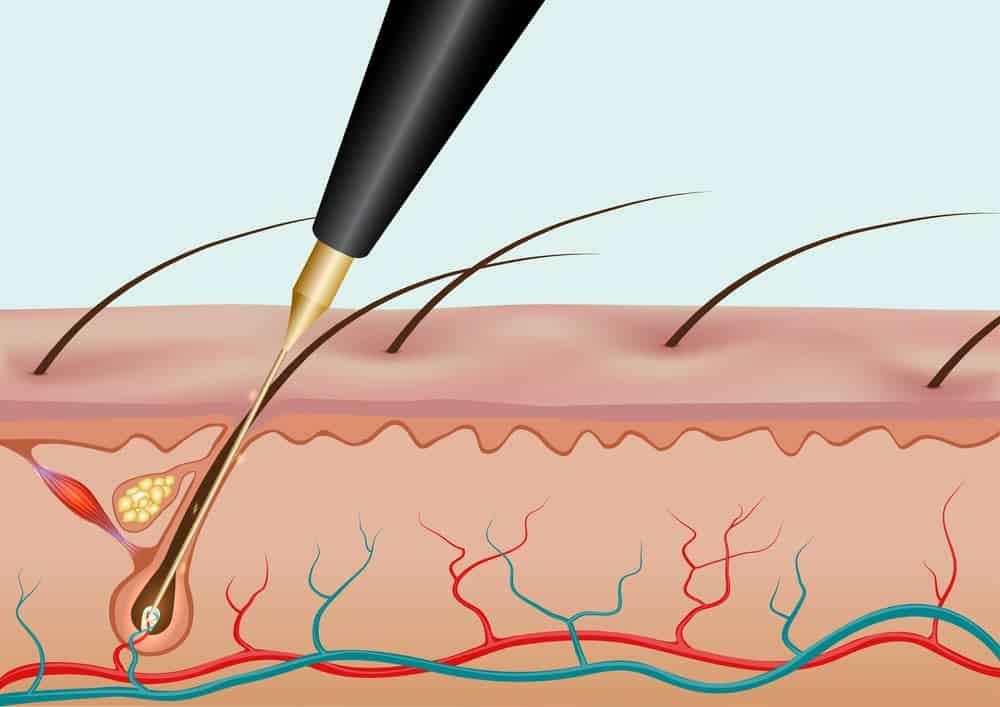So you’ve decided to use technology to remove some hair and you want to know about your options. We get it — waxing is exceptionally painful and shaving constantly is annoying at best. The two most common, long-term solutions for hair removal are electrolysis and lasers, and it turns out that both procedures are as rad as they sound.
Both methods of hair removal attack the hair follicle, which is essentially the hair cell from which it grows. By destroying or otherwise disrupting this follicle, your hairs either won’t grow back or will do so in a vastly diminished, less noticeable way. For me personally, electrolysis put an end to regular waxing sessions, and that’s just glorious.
We’re going to compare both of these procedures, looking at their differences and what makes each great. By the end of this article, you should know which method would suit you best, so let’s dive right in.
What is electrolysis?
Electrolysis involves attacking the hair follicle with a mild current of electricity, which kills it and prevents the hair from growing back.
Currently, the American Food and Drug Administration only recognizes electrolysis as a permanent method of hair removal. Right off the bat this would be considered a big plus in the eyes of most people, as getting rid of unwanted hair forever is a beautiful thing. Because of this, however, this procedure needs to be done by a licensed dermatologist or an electrologist, which means there is a bit more planning involved.
Before your first appointment, you will consult with the professional doing the procedure. They will likely go over relevant medical history, any adverse conditions in your skin and other relevant factors that could affect searing your hair with electricity. Though this procedure has been used with increasing frequency after World War 2, the first uses of electrolysis for hair removal date all the way back to 1875.
Procedure
Once you’ve had your consultation, the area to be worked on will be shaved and prepped, which usually involves antiseptic being applied. The technician will use an exceptionally thin needle to apply direct electric current to the hair follicle, killing it. This process will be repeated just so many times because you have a lot of hair follicles, and each session will only reasonably be able to cover a small area.
Pros
Electrolysis is a simple if time-consuming procedure, but it does come with a list of fantastic upsides:
- Currently, (that’s an electricity joke) it’s the only permanent hair removal solution recognized by the FDA.
- There’s no real recovery time or danger for long-term damage. Though some irritation can occur and rarely follicles can get infected, these results are rare.
- Since the results are permanent, you no longer have to pay for waxing or spend your time shaving.
- There are no chemicals, peels or blades applied to your skin with electrolysis, so the damage is exceptionally localized to the hair follicle, as is any resulting irritation.
- Sessions are reasonably cheap, between $30 and $50, and it’s possible your insurance could pay for it under certain circumstances.
Cons
- The biggest downside to this process is the time it takes. Only a small area can be treated each session, so doing something like your legs, shoulders or back will take up to a year to finish.
- Coarse areas like your bikini line or the male jaw will take several sessions to full neutralize the root.
- Though each session is not unreasonably priced, you may have more sessions in the long run, so cost can be a factor here.
What is laser hair removal?
I think we all suspected lasers would be more involved in our lives in the future, but despite that not being the fact, they still provide some wonderful services like hair removal. Laser treatments are similar to electrolysis treatments, in that they damage the hair follicle. This will impede growth and diminish size of the hair, but not fully kill the cell. This means laser hair removal will require repeated visits, but not nearly as much as waxing or shaving.
Procedure
This isn’t the same type of level that electrolysis is at in terms of complexity, so you can get this done at many salons and spas. The person doing the procedure will shave the area to get the hair back down to the skin level, which allows the laser better access to the follicle. After that, you’ll be given topical anesthetic and a gel that provides a safety barrier between the laser and your skin, as well as some eye protection.
The laser itself hits a much wider area than the needle used in electrolysis, which means far more hair can be treated each session. This is fantastic because it can take upwards of 6 treatments to an area to sufficiently damage the cell and diminish hair growth.
Once you’ve gone 6-8 times, your technician will likely have you in only once or twice a year from that point forward. Remember, though long-term care is very far apart, this still is not considered a “permanent” hair removal technique.
Laser hair removal started to become popular in the 1990s, pushing its way into the market because of its widespread availability compared to electrolysis.
Pros
Laser hair removal may not be permanent, but it’s definitely got some benefits:
- The process is much faster than electrolysis, covering a larger area in a shorter time.
- It’s faster at diminishing coarse hair, like beards or bikini areas.
- You’ll notice the change rather quickly; within a few sessions in most cases.
Cons
- Laser hair removal makes the skin around the follicles exceptionally sensitive to sunlight for up to several months afterward. Not only does this increase your risk of burning, but it also can cause uneven tanning as the light-sensitive patches will tan at a different rate than the surrounding tissue.
- This process functions best on light skin with dark hair, as it diminishes the thickness and color of the hair shaft itself. For coarser hair or darker skin, the effects won’t be as noticeable and electrolysis would be a better choice as it actually removes the hair entirely.
Which is best?
While there’s no real “best” here, we can examine both in terms of what might serve your needs the best. Let’s look at a few categories where they can be reasonably compared.
Cost
Laser hair removal is the more expensive procedure per visit at around $200, compared to around $40 for electrolysis. While laser hair removal affects a larger area and can provide results in as little as 3 visits, the effects aren’t permanent, and so you’ll need touch-ups once or twice a year after your initial applications. This can add up to around $1000 or more initially, with a further $200-$400 per year after that.
Electrolysis is permanent, but it’s a slower process and at $40 each visit, you might end up going far longer. Still, it’s possible that your insurance will cover it because it’s more akin to a medical procedure and can be considered a causal agent of anxiety or other conditions. Ultimately, electrolysis is probably the most cost-effective treatment but does take far longer for results.
Efficacy
Laser hair removal is great if you’ve got a pool party in a few weeks or you’re contouring for summer, as it can take effect very quickly. You can also get whole areas done at a time, which is also a time saver.
Electrolysis will be great when all the treatments have been applied, but the small patches and long-term commitment make it less useful for impending events. If you’ve got a cool party or a hot date in a month, laser hair removal is better for you.
Downsides and risks
Though neither procedure carries extreme risks, both do have some potential side effects. Electrolysis hurts more than laser hair removal, and in some cases can cause infection at the follicle site. Laser hair removal, on the other hand, can cause weeks of sensitivity, numbness, pain or irritation. Though these aren’t common side effects, and they’re not exceptionally life-altering, they can be frustrating.










